Down To Earth (October 1-15 2023)
Carbon Trade and Emission Control
Context:
- As per the assessment of Centre for Science and Environment (CSE), India generates one-fifth of the world’s carbon credits and is at the forefront of carbon investment.
About:
- Buying and selling of carbon credits is seen as an important way to combat climate change. The concept works by assigning credits to projects that reduce greenhouse gases.
- These credits, measured in tonnes of carbon dioxide-equivalent (CO2e), then get priced and traded.
- People and businesses that wish to offset the emissions generated by their activities can buy these credits and ‘neutralise’ the carbon footprint.
- A voluntary carbon market has grown at a record pace in the past decade. In this marketplace, emission-reducing projects are registered, verified and validated, and carbon credits traded in the hope that money from the transaction would help mitigate emissions.
Types of carbon markets:
- Compliance markets: These are created as a result of any national, regional and/or international policy or regulatory requirement.
- Voluntary carbon markets (national and international): These refer to the issuance, buying and selling of carbon credits, on a voluntary basis.
- The current supply of voluntary carbon credits comes mostly from private entities that develop carbon projects, or governments that develop programs certified by carbon standards that generate emission reductions and/or removals.
Carbon Trade Agreements:
|
Carbon Trading Agreement Post Glasgow COP26:
- Rules for a global carbon market were established at the Glasgow COP26 climate change conference in November 2021, enacting an agreement first laid out at the 2015 Paris Climate Agreement.
- The agreed-upon framework, known as Article 6, will comprise a centralised system and a separate bilateral system.
- The centralised system is for the public and private sectors, while the bilateral system is designed for countries to trade carbon offset credits, helping them meet their emission targets.
- The new rules allow participants to use previous credits created between 2013 and 2020, prompting fears that they could potentially saturate the market and put downward pressure on prices.
- Under the new agreement, those who create carbon credits will deposit 5% of proceeds generated into a fund to help developing countries tackle climate change. Also, 2% of credits will be cancelled to ensure an overall reduction in emissions.
Conclusion:
- However, there is no ‘official’ carbon market established, and the global community is still discussing the rules that will govern such trade.
- On the other hand, proponents of the framework say that it creates financial incentives for countries and companies to create emission-reducing technology and initiatives, such as mechanical carbon capture systems and forest planting—all of which will help reduce carbon levels in the atmosphere.
Carbon Market and Greenhouse Gas Emissions
Context:
- Voluntary carbon market is growing rapidly which is driven by private entities, mostly industries and businesses.
About:
- Carbon market has the potential to unlock billions of dollars for countries in the Global South that need financing to transition to a low-carbon energy system and to ensure socio-economic development of their communities.
- It is clear that the world is failing by many marks to reduce greenhouse gas emissions.
- The climate change crisis has now reached every country, and extreme weather events are costing all economies.
- This market would put a price on every tonne of carbon dioxide or the equivalent greenhouse gas avoided, reduced or sequestered, which can then be used to offset emissions of companies and countries.
Do you know?
|
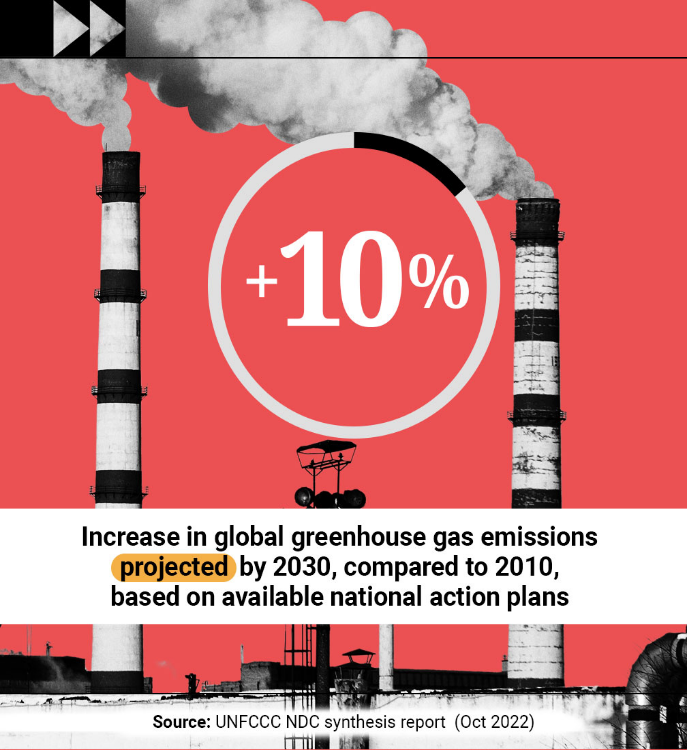
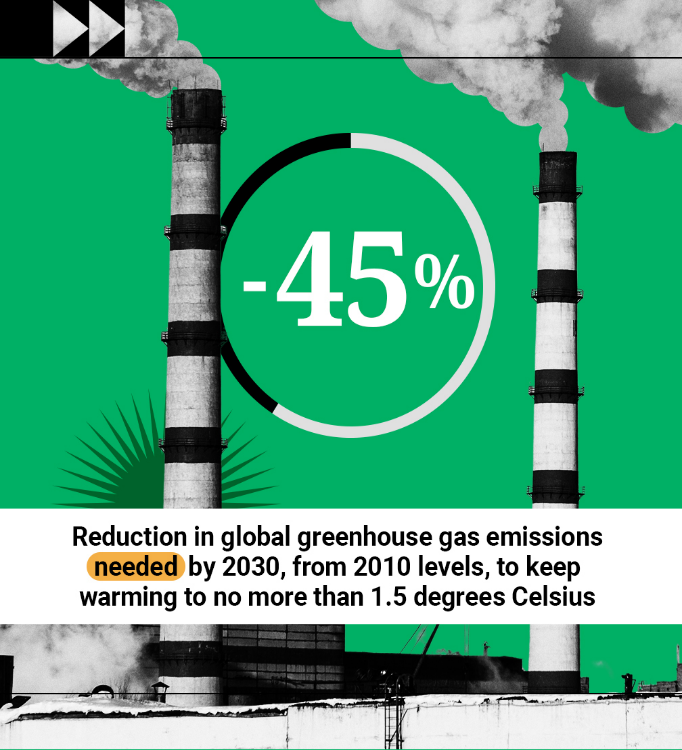
What is net zero?
- It means cutting greenhouse gas emissions to as close to zero as possible, with any remaining emissions re-absorbed from the atmosphere, by oceans and forests for instance.
Why is net zero important?
- The science shows clearly that in order to avert the worst impacts of climate change and preserve a livable planet, global temperature increase needs to be limited to 1.5°C above pre-industrial levels.
- Currently, the Earth is already about 1.1°C warmer than it was in the late 1800s, and emissions continue to rise.
- To keep global warming to no more than 1.5°C (as called for in the Paris Agreement) emissions need to be reduced by 45% by 2030 and reach net zero by 2050.
How can net zero be achieved?
- The energy sector is the source of around three-quarters of greenhouse gas emissions today and holds the key to averting the worst effects of climate change.
- Replacing polluting coal, gas and oil-fired power with energy from renewable sources, such as wind or solar, would dramatically reduce carbon emissions.
- It calls for nothing less than a complete transformation of how we produce, consume, and move about.
Is there a global effort to reach net zero?
- More than 70 countries, including the biggest polluters – China, the United States, and the European Union – have set a net-zero target, covering about 76% of global emissions.
- More than 3,000 businesses and financial institutions are working with the Science-Based Targets Initiative to reduce their emissions in line with climate science.
- And more than 1000 cities, over 1000 educational institutions, and over 400 financial institutions have joined the Race to Zero, pledging to take rigorous, immediate action to halve global emissions by 2030.
Are we on track to reach net zero by 2050?
- Current national climate plans – for 193 Parties to the Paris Agreement taken together – would lead to a sizable increase of almost 11% in global greenhouse gas emissions by 2030, compared to 2010 levels.
- Getting to net zero requires all governments – first and foremost the biggest emitters – to significantly strengthen their Nationally Determined Contributions (NDCs) and take bold, immediate steps towards reducing emissions now.
- The Glasgow Climate Pact called on all countries to revisit and strengthen the 2030 targets in their NDCs by the end of 2022, but only 24 new or updated climate plans were submitted by September 2022.
Most emissions come from just a few countries:
- The top seven emitters (China, the United States of America, India, the European Union, Indonesia, the Russian Federation, Brazil) accounted for about half of global greenhouse gas emissions in 2020.
- The Group of 20 (Argentina, Australia, Brazil, Canada, China, France, Germany, India, Indonesia, Italy, Japan, Republic of Korea, Mexico, Russia, Saudi Arabia, South Africa, Turkey, the United Kingdom, the United States, and the European Union) are responsible for about 75 per cent of global greenhouse gas emissions.
What is next?
- It is hoped that soon there will be an internationally negotiated agreement for an official carbon market.
- At the next Conference of the Parties (COP 28) to the UNFCCC to be held at the end of the year, discussion on creating the rules for the carbon market (Article 6 of the Paris Agreement of 2015) is top billed.
- Once these rules are finalised, there will be a public registry of all projects and countries will be allowed to trade either bilaterally (under Article 6.2) or through a global programme like what existed earlier under CDM (under Article 6.4).
- Developing countries, including India, need financing to transition to a low-carbon energy system, and the buying and selling of carbon credits will provide that investment.
Carbon Market and India
Context:
- India announced that it was open to the export of carbon credits with countries that buy green hydrogen from India.
About:
- Amendment to the Energy Conservation Act, 2001 was proposed to create a domestic carbon market in India, and to empower the central government to specify a carbon credit trading scheme.
- It will have to be generated and bought by domestic and overseas markets and will not be applicable to the voluntary carbon market.
- Under the Paris Agreement of 2015, India has pledged to reduce the emissions intensity of its GDP by 45% by 2030, from the 2005 level.
- The government issued a notification, detailing the framework of Indian carbon market under the Carbon Credit Trading Scheme, 2023, but does not include voluntary markets.
Highlights of the Bill to amend the Energy Conservation Act, 2001:
Key Issues and Analysis:
|
Due Credit:
|
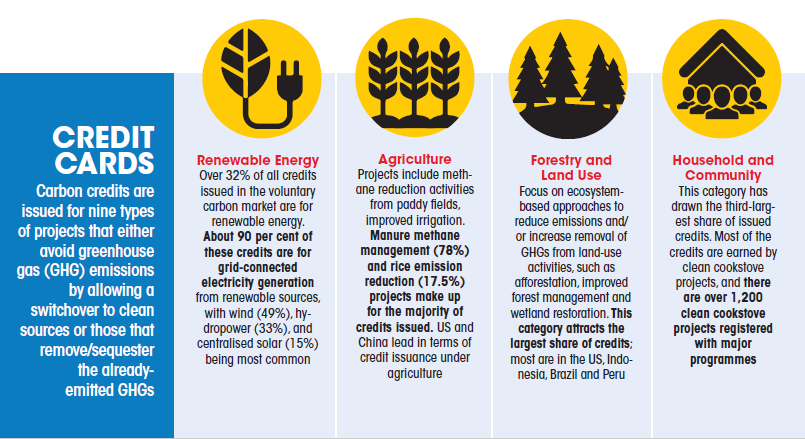
Voluntary Carbon Market
Context:
- The global voluntary carbon market (VCM) sector has exploded in recent years, and India has been an integral part of this boom, and has become the world’s second-largest source of carbon offsets in the voluntary carbon market.
About:
- Voluntary carbon market is a sophisticated ecosystem. It involves a multitude of players to ensure that a carbon offset project delivers on its claims—that it avoids or removes greenhouse gases from the atmosphere.
- The price of a carbon credit is strictly decided between the buyer and seller, who trade behind closed doors.
- Globally, 2 registries with 6,481 projects have issued carbon credits for avoiding/slashing 1.4 billion tonnes of emissions.
- Annual transaction of the market was $2 billion in 2021.
- The price of carbon credits is dictated by market factors that do not necessarily serve the purpose of decarbonisation.
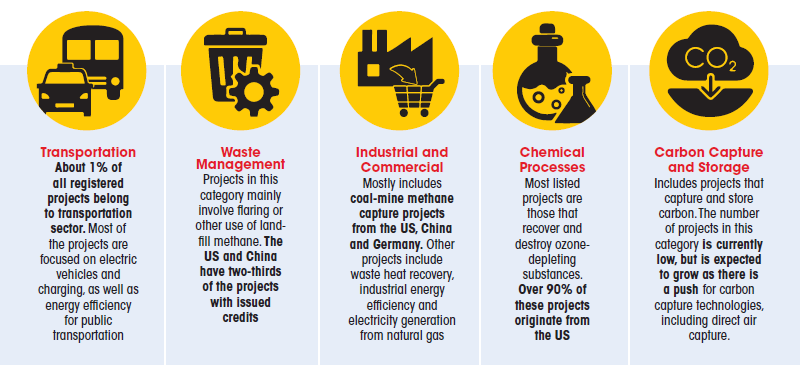
Carbon Registries:
- The registries are organisations that make standards and guidelines for project development, verification and trading.
- They provide a platform for the project developer, which can be a private or public entity, to register their project and for these to be verified, and then issues carbon credits for verified projects that meet the criteria and demonstrate greenhouse gas reduction or removal.
- The project developer, which designs the project and is responsible for its implementation as well as monitoring, ensures that the credits meet the standards for reduction or removal of greenhouse gas emissions.
- The carbon credits that they earn from these registered projects can then be traded and used by companies to offset their emissions and meet climate goals.
- The Verified Carbon Standard Program (VCS), the biggest global registry, has 64% of the independent (non-governmental) credits issued globally.
- Gold Standard, the second biggest global registry, followed by American Carbon Registry (ACR) and Climate Action Reserve (CAR), formerly California Climate Action Registry.
- A relatively new player is Qatar-based Global Carbon Council (GCC) registry, which was founded in 2016 and has since approved nine projects, a number of which are related to renewable energy.
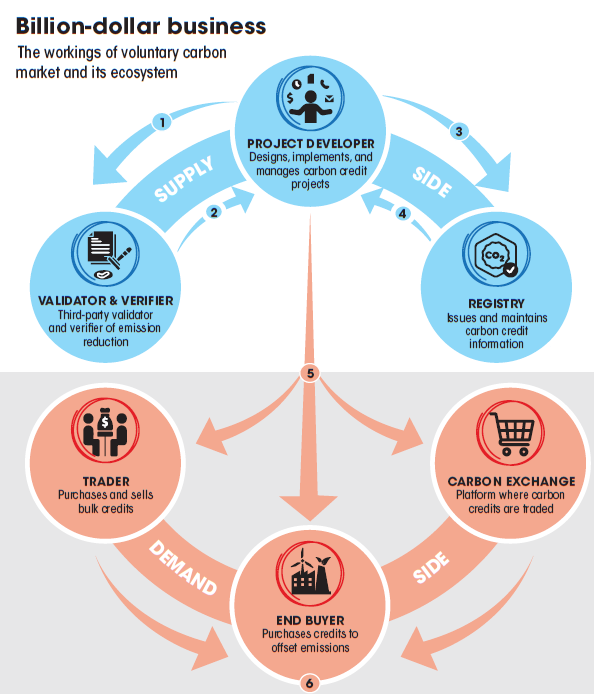
Issues in voluntary carbon market:
- One of the fundamental flaws of the voluntary carbon market is that it has no basis of the price that it puts on the project; at times it is inflated and at times it is so low that the project becomes unviable.
- It seems that the entire purpose of this market is to serve the interest of the retinue of project developers, auditors and all the others who make a cut in this carbon business.
- The current carbon markets could end up increasing emissions in the world. The buyers of the credit—say an airline company that has assured its customers to offset their carbon footprint or a food company that has declared itself net-zero—have continued to emit; they have even increased their emissions, saying that they have bought credits.
- But as these credits have been overestimated or do not really exist, the reductions are notional. This is a double-jeopardy. This is what the climate-risked world does not need.
In India:
- In India (as in most other countries), no government database exists on the number of projects that have been signed by different entities for carbon credits. The information is only available with global carbon registries.
- Three Indian companies made it to the top 15 project developers list—EnKing International, Jaiprakash Power Ventures and Himachal Baspa Power Company.
- Nearly 1,451 projects implemented across India to churn out the new-age essential commodity—carbon credits. Industries and businesses in the West are vying for these credits to clean up their emissions.
- Governments world over continue to issue regulations to rein in the voluntary carbon market, hold it accountable for its acts and ensure sharing of the proceeds with communities. But these steps may not work without international rules to regulate the market.
- In India, the voluntary market must be regulated and made to contribute to the country’s climate goals.
Regulating carbon market
Context:
- Governments across the world have begun to voice concerns about the unregulated nature of the voluntary carbon market.
About:
- India is enacting legislations and policies by different ministries—and it is not clear how coordinated these actions are—to create and regulate a carbon credits market and to incentivise people to join a green credits programme.
Carbon Credit Trading Scheme:
- The Union Power Ministry issued a notification on its Carbon Credit Trading Scheme. Under this, the government would constitute a National Steering Committee for the Indian carbon market.
- The committee would be tasked with the governance of the Indian carbon market and direct oversight of its functioning.
- The Bureau of Energy Efficiency, an agency under the Power Ministry, would be the designated administrator of the Indian carbon market, which will issue carbon credits based on the recommendations provided by the committee.
- The Grid Controller of India Limited shall act as the registry and the Central Electricity Regulatory Commission will be the regulator.
- The notification is silent on the voluntary carbon market or the issue of export of credits.
Draft Green Credit Programme Implementation Rules, 2023:
- It was notified by the Union Environment Ministry.
- The programme is a domestic voluntary market that incentivises voluntary environmental actions so that it promotes the government's Mission LIFE (Lifestyle for Environment).
- It has listed actions, including planting trees, which would get ‘green credits’ and is described as ‘singular unit of an incentive provided for a specified activity delivering a positive impact on the environment’.
- It goes on to say that an activity generating green credits under the green credit programme may also acquire carbon credits for the same activity under the carbon market.
- These green credits will be traded on a domestic market platform.
- The steering committee will be in charge of governance while the administrator will be responsible for implementing the programme, including its management, monitoring and operation.
- The Indian Council of Forestry Research and Education will be the administrator, who will create technical or sectoral committees to develop methodologies, standards and processes for registration of green credit activities and grant of green credits.
- Perhaps the most important aspect of this scheme is that it opens the compensatory afforestation activities by private entities to incentives and participation in the domestic carbon market.
Carbon Credits and Countries across the world:
- HONDURAS (2022): It imposes a moratorium on the sale of forest-based carbon credits to avoid the colonisation of carbon in the country’s forests.
- NIGERIA (2023): It announces plans to regulate the voluntary carbon market. It says that sellers of carbon credits need to comply with local regulations and that it is preparing proposals for carbon pricing.
- The government wants to ensure that every opportunity for harvesting emission reduction certificates from ongoing activities in Nigeria is linked to its NDCs.
- RWANDA (2023): In an effort to shift the control of carbon pricing from buyers to Rwanda, the government says that it will not sell carbon credits below $30 per tonne of CO2e.
- ZIMBABWE (2023): It says it would closely regulate voluntary carbon offset trading over fears of greenwashing and also ensure that local communities benefit from it.
- The country plans to charge an environment levy of 30% on projects (and allow developers to keep 70 per cent share) if communities are not involved. If local communities are affected, project developers would need to provide a quarter of the 70% to the people.
- EGYPT (2023): Egypt's financial regulator puts forth regulations on the process of verifying and certifying carbon credits to provide an ‘effective’ mechanism for measuring, recording and documenting projects.
- KENYA (2023): It proposes a new legislative draft of the Carbon Credit Trading and Benefit Sharing Bill, 2023, to establish a regulatory framework for carbon credit trading and benefit-sharing, and an authority to oversee the trading.
- INDONESIA (2022): The government imposes conditions on the export of carbon credits. It had earlier sent a letter to Verra and a few other voluntary market registries, telling them that they cannot issue credits from 2021 without the government’s permission.
- PAPUA NEW GUINEA (2022): The government issues a moratorium on voluntary carbon credit deals to protect the country from carbon scams, involving consent and benefits-sharing.
- TANZANIA (2022): It introduces a list of regulations to control and manage carbon trading projects.
- MALAWI (2023): It says it would review voluntary carbon market projects on its territory.
- ZAMBIA (2022): It develops Interim Guidelines for Handling of Carbon Markets and Trading In Zambia that aim to ensure the country’s trade and regulation of carbon meet international best practices while also benefiting local communities that own the natural resources.
Regulating Carbon Market:
- Ensuring Transparency: It has found that the big project developers, carbon registries and the big and small non-profits involved have no transparency; communities are unaware of carbon credits; there is overestimation of carbon credits; ownership rights on trees of poor tribals have been transferred to private entities; and worse, there is no real sharing of benefits with the people who are required to change their behaviour.
- The details of the projects should be listed. There should be information about the price that each credit has earned.
- Pay for real change: Decide once and for all the objective of the market—voluntary, bilateral or multilateral—and design rules accordingly.
- Consider renewable energy projects, which are critical for making the transition to clean energy in countries.
Way ahead:
- At the next UN Climate Conference (COP28) in Dubai later this year, the issue of regulation of a carbon market will be discussed.
- World leaders need to learn from the mistakes of the voluntary carbon market so that this new market mechanism, which is designed for transformation in the world, does not repeat those.
Subjective Questions
- What do you understand about the ‘Carbon Market’? How far can it solve the problem of global warming?
- Is it possible for the countries to achieve the target of ‘net zero’ using carbon trade?
- What is the voluntary carbon market? Why is regulation of the carbon market necessary to achieve the current pledge under the Paris Climate Deal?
QUICK LINKS